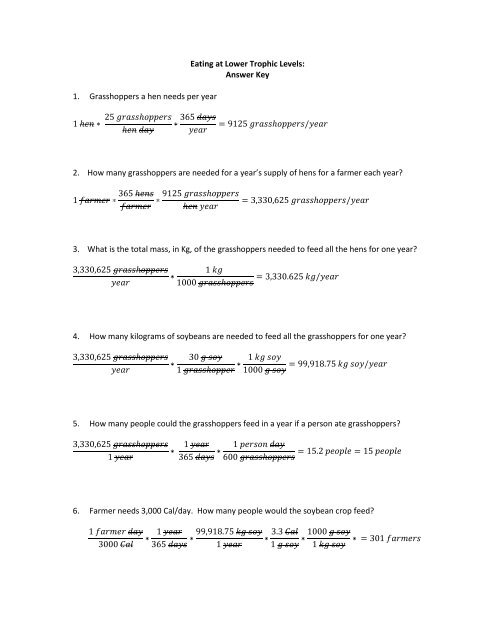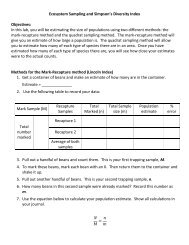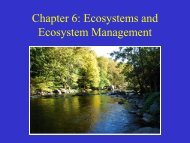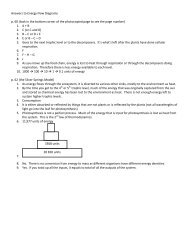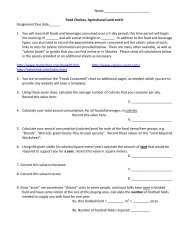Eating at Lower Trophic Levels: Answer Key 1. Grasshoppers a hen ...
Eating at Lower Trophic Levels: Answer Key 1. Grasshoppers a hen ...
Eating at Lower Trophic Levels: Answer Key 1. Grasshoppers a hen ...
Create successful ePaper yourself
Turn your PDF publications into a flip-book with our unique Google optimized e-Paper software.
<strong>1.</strong> <strong>Grasshoppers</strong> a <strong>hen</strong> needs per year<br />
<strong>E<strong>at</strong>ing</strong> <strong>at</strong> <strong>Lower</strong> <strong>Trophic</strong> <strong>Levels</strong>:<br />
<strong>Answer</strong> <strong>Key</strong><br />
2. How many grasshoppers are needed for a year’s supply of <strong>hen</strong>s for a farmer each year?<br />
3. Wh<strong>at</strong> is the total mass, in Kg, of the grasshoppers needed to feed all the <strong>hen</strong>s for one year?<br />
4. How many kilograms of soybeans are needed to feed all the grasshoppers for one year?<br />
5. How many people could the grasshoppers feed in a year if a person <strong>at</strong>e grasshoppers?<br />
6. Farmer needs 3,000 Cal/day. How many people would the soybean crop feed?
7. Biomass pyramid<br />
Not drawn to scale!<br />
<strong>hen</strong>s<br />
99,918.75 kg soy<br />
person<br />
33,330.625 kg grasshoppers<br />
8. Should people generally e<strong>at</strong> <strong>at</strong> a lower trophic level?<br />
a. Pros: planet could sustain far more people. W<strong>hen</strong> the farmer was e<strong>at</strong>ing <strong>hen</strong>s, the<br />
ecosystem could supply just one farmer. W<strong>hen</strong> the farmer <strong>at</strong>e soybeans, could sustain<br />
over 300 farmers. <strong>E<strong>at</strong>ing</strong> the producers r<strong>at</strong>her than feeding on the 3 rd trophic level<br />
could support 300 times more people in this situ<strong>at</strong>ion. An additional pro is th<strong>at</strong> e<strong>at</strong>ing<br />
vegetables Is healthier, especially if e<strong>at</strong>ing a well balanced diet. Too much me<strong>at</strong> can be<br />
bad for your health.<br />
Cons: <strong>E<strong>at</strong>ing</strong> lower on the food chain could result in broader areas used for<br />
monoculture, therefore getting rid of much biodiversity. Also, without the <strong>hen</strong>s, the<br />
grasshopper popul<strong>at</strong>ion could explode, causing a decrease in the soy popul<strong>at</strong>ion. Until<br />
the grasshopper popul<strong>at</strong>ion stabilized, there would need to be higher soy production to<br />
support both the farmers and the grasshoppers.<br />
b. In countries where food is scarce, it makes more sense for people to e<strong>at</strong> the producers<br />
r<strong>at</strong>her than the consumers. Much energy is lost between the producers and cows, t<strong>hen</strong><br />
between the cows and the people. Developing n<strong>at</strong>ions (as well as developed n<strong>at</strong>ions)<br />
could support more people or have a lower environmental impact if people <strong>at</strong>e <strong>at</strong> lower<br />
trophic levels.<br />
9. Omnivores, such as coyotes, r<strong>at</strong>s and humans, can e<strong>at</strong> on multiple trophic levels. This allows<br />
them to e<strong>at</strong> higher w<strong>hen</strong> the food is available, but lower on the food chain w<strong>hen</strong> me<strong>at</strong> is scarce.<br />
Having the ability to e<strong>at</strong> both me<strong>at</strong> and vegetables increases the opportunities to find food.<br />
10. Foods e<strong>at</strong>en (answers will vary, but mine: cereal, milk, cheese, bread, onion and pesto pizza)<br />
a. Most food came from the first trophic level (cereal, bread, onion, pesto, pizza dough);<br />
though some came from the second trophic level (milk, cheese, butter on bread).<br />
b. Approxim<strong>at</strong>ely 75% of the mass came from the first trophic level, 25% from the 2 nd .<br />
c. W<strong>hen</strong> I e<strong>at</strong> fish, I primarily e<strong>at</strong> salmon, which is on the 3 rd trophic level (salmon e<strong>at</strong> krill<br />
which e<strong>at</strong> phytoplankton). Less than 10% of my diet is from the 3 rd trophic level.<br />
1<strong>1.</strong> Bioaccumul<strong>at</strong>ion: Chemicals such as mercury are not excreted by animals or plants. W<strong>hen</strong> a<br />
plant takes up the mercury, all of th<strong>at</strong> mercury is taken into the next trophic level (likely the<br />
zooplankton, such as krill). Krill need to consume quite a lot of phytoplankton to sustain<br />
themselves, and therefore e<strong>at</strong> a lot of mercury. In turn, the salmon e<strong>at</strong> the krill, and therefore<br />
accumul<strong>at</strong>e more mercury. Finally, we e<strong>at</strong> the fish, so the mercury becomes a part of us.


